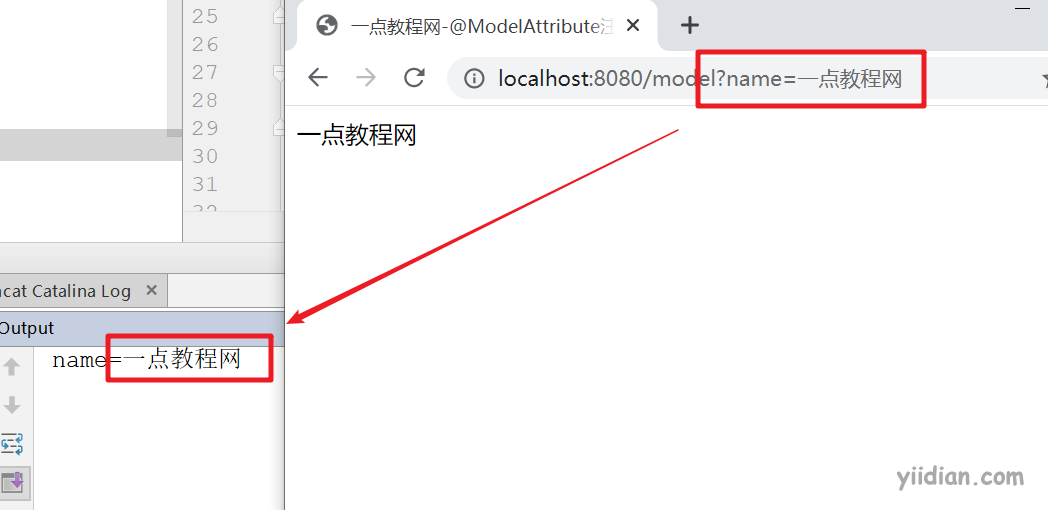1 @ModelAttribute作用
@ModelAttribute注解的作用,将请求参数绑定到Model对象。被@ModelAttribute注释的方法会在Controller每个方法执行前被执行(如果在一个Controller映射到多个URL时,要谨慎使用)。
2 @ModelAttribute使用位置
在SpringMVC的Controller中使用@ModelAttribute时,其位置包括下面三种:
- 应用在方法上
- 应用在方法的参数上
- 应用在方法上,并且方法同时使用@RequestMapping
3 应用在方法上
3.1 用在无返回值的方法
1)编写ModelAttributeController
package com.yiidian.controller;
import org.springframework.stereotype.Controller;
import org.springframework.ui.Model;
import org.springframework.web.bind.annotation.ModelAttribute;
import org.springframework.web.bind.annotation.RequestMapping;
import org.springframework.web.bind.annotation.RequestParam;
/**
* @ModelAttribute注解的使用
* 一点教程网 - www.yiidian.com
*/
@Controller
public class ModelAttributeController {
//没有返回值的情况
@ModelAttribute
public void myModel(@RequestParam(required = false) String name, Model model) {
model.addAttribute("name", name);
}
@RequestMapping(value = "/model")
public String model() {
return "success";
}
}
在model方法之前会执行myModel方法。因此在myModel方法中,请求传递的name参数存入Model对象,该参数值也会随着model方法带到JSP页面中。
2)页面获取数据
<%@ page contentType="text/html;charset=UTF-8" language="java" %>
<html>
<head>
<title>一点教程网-@ModelAttribute注解的使用</title>
</head>
<body>
${name}
</body>
</html>
3)运行测试
 3.2 用在带返回值的方法
3.2 用在带返回值的方法
1)ModelController类
package com.yiidian.controller;
import org.springframework.stereotype.Controller;
import org.springframework.ui.Model;
import org.springframework.web.bind.annotation.ModelAttribute;
import org.springframework.web.bind.annotation.RequestMapping;
import org.springframework.web.bind.annotation.RequestParam;
/**
* @ModelAttribute注解的使用
* 一点教程网 - www.yiidian.com
*/
@Controller
public class ModelAttributeController {
/**
* 带返回值的情况
* @param name
*/
@ModelAttribute("name")
public String myModel(@RequestParam(required = false) String name) {
return name;
}
@RequestMapping(value = "/model")
public String model() {
return "success";
}
}
带有返回值的情况,其实就是自动把方法返回值存入Model对象,@ModelAttribute的value属性就是Model的key。相当于
model.addAttribute("name",name);
2)页面取值
<%@ page contentType="text/html;charset=UTF-8" language="java" %>
<html>
<head>
<title>一点教程网-@ModelAttribute注解的使用</title>
</head>
<body>
${name}
</body>
</html>
4 应用在方法的参数上
@ModelAttribute("name")
public String myModel(@RequestParam(required = false) String name) {
return name;
}
//应用在方法的参数行
@RequestMapping(value = "/model")
public String model(@ModelAttribute("name") String name) {
System.out.println("name="+name);
return "success";
}
@ModelAttribute注解应用在方法的参数上,其实就是从Model对象中取出对应的属性值。
效果如下:

5 方法上+@RequestMapping
//@ModelAttribute,@RequestMapping同时放在方法上
@RequestMapping(value = "/model")
@ModelAttribute("name")
public String model(@RequestParam(required = false) String name) {
return name;
}
@ModelAttribute和@RequestMapping同时应用在方法上的时候,有两层意义:
- 方法的返回值会存入Model对象中,key就是ModelAttribute的value属性值
- 方法的返回值不再是方法的访问路径,访问路径会变为@RequestMapping的value值,例如:@RequestMapping(value = "/model") 跳转的页面是model.jsp页面。
总之,@ModelAttribute注解的使用的方法有很多种,非常灵活,我们可以根据业务需求选择使用。
源码下载:https://pan.baidu.com/s/1vITHgILkoAyvbt_k6fyhCg
Java 面试宝典是大明哥全力打造的 Java 精品面试题,它是一份靠谱、强大、详细、经典的 Java 后端面试宝典。它不仅仅只是一道道面试题,而是一套完整的 Java 知识体系,一套你 Java 知识点的扫盲贴。
它的内容包括:
- 大厂真题:Java 面试宝典里面的题目都是最近几年的高频的大厂面试真题。
- 原创内容:Java 面试宝典内容全部都是大明哥原创,内容全面且通俗易懂,回答部分可以直接作为面试回答内容。
- 持续更新:一次购买,永久有效。大明哥会持续更新 3+ 年,累计更新 1000+,宝典会不断迭代更新,保证最新、最全面。
- 覆盖全面:本宝典累计更新 1000+,从 Java 入门到 Java 架构的高频面试题,实现 360° 全覆盖。
- 不止面试:内容包含面试题解析、内容详解、知识扩展,它不仅仅只是一份面试题,更是一套完整的 Java 知识体系。
- 宝典详情:https://www.yuque.com/chenssy/sike-java/xvlo920axlp7sf4k
- 宝典总览:https://www.yuque.com/chenssy/sike-java/yogsehzntzgp4ly1
- 宝典进展:https://www.yuque.com/chenssy/sike-java/en9ned7loo47z5aw
目前 Java 面试宝典累计更新 400+ 道,总字数 42w+。大明哥还在持续更新中,下图是大明哥在 2024-12 月份的更新情况:

想了解详情的小伙伴,扫描下面二维码加大明哥微信【daming091】咨询

同时,大明哥也整理一套目前市面最常见的热点面试题。微信搜[大明哥聊 Java]或扫描下方二维码关注大明哥的原创公众号[大明哥聊 Java] ,回复【面试题】 即可免费领取。

